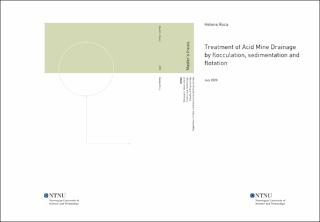| dc.description.abstract | Acid Mine Drainage (AMD) and as consequence Metal Leaching (ML) is known to cause environmental pollution affecting many areas with historic or current mining industries. The Killingdal Area by the Trondheim fjord in Norway is suffering from it. The water is being collected and treated following chemical precipitation, flocculation and sedimentation. The treated water, when discharged to the recipient, needs to fulfil the requirements set out by the Norwegian Environment Agency's discharge permit by 2021.
The present study aims to improve the actual treatment train of the Killingdal site in terms of Suspended Solid Removal (SSR) and sludge volume and quality. Study I analyses the solubility of metals in the raw water by pH modification. This was done by a titration sequence and scanning the metal content (Al, Fe, Ni, Cd, Pb, Cr, Zn and Cu) dissolved in the water with an Inductively Coupled Plasma Mass Spectrometry (ICP-MS). Study II pretends to Improve the flocculation step by analyzing the polymer type (EPIDMA and PAM) and dose and see how this affected the SSR (Sedimentation or flotation) and the sludge quality. The experiments were carried out by a series of jar tests. The variables of study were the: Polymer type, polymer dosage and two different SSR methods. SSR efficiency was evaluated by measuring the turbidity of the water and the metal content in the treated water. Sludge quality was evaluated according to the dewaterability with a Capillary Suction Time (CST).
Experimental results showed that in Study I, the optimal pH for the maximum removal of dissolved metals in the water was between 9 and 10. Study II showed that both SSR unit treatments (sedimentation and flotation) give satisfactory results. EPIDMA polymer is adequate for sedimentation and the optimal dose is 8.3mg/L. PAM works better for the flotation and the optimal dose for SSR is between 5 and 10 mg/L. Neither sedimentation nor flotation fulfill the requirements of the metals limit discharge to the fjord despite the optimization. In the flotation; quantitative results for the sludge conditioning are not clear neither its performance nor its quality, however the qualitative results look very promising.
Further studies need to be done to confirm this last conclusion. Since the SSR do not fulfill the environmental requirements, another treatment unit need to be added to the train. The lime step should be evaluated in another set of experiments to compare the sludge quality. The design of the sedimentation and flotation units scaled to the pilot need to be studied. Bio-sulfidogenic reactors could be a potential solution to lower the content of metals in the treated water and in the SSR sludge product.
Keywords: Acid mine drainage (AMD), Metal Leaching (ML), chemical precipitation, flocculation, sedimentation, flotation, sludge management. | |
